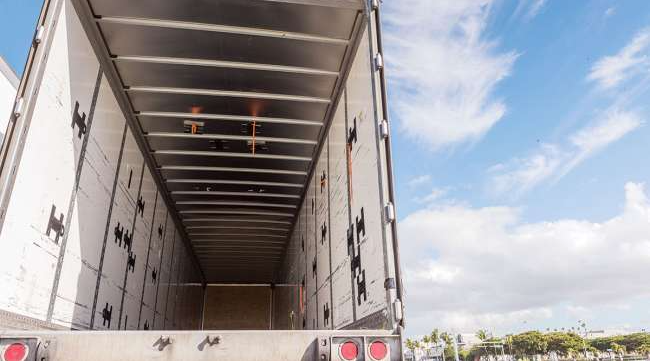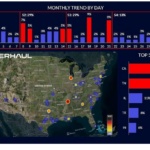Experts have cautioned that the trucking industry anticipates a rise in cargo theft incidents during the peak shipping season, which comes amid already high levels of such activity.
According to Overhaul, a supply chain risk management and intelligence firm, cargo thefts increased with the start of the peak shipping season in August. The company noted that this period traditionally brings greater security risks and believes that this upward trend in thefts is likely to persist.
“So far, this has been a record-breaking year on all fronts for supply chain security and cargo thefts,” said Danny Ramon, director of intelligence and LE connect at Overhaul. “I expect to see that continue into the fourth quarter. I expect this is going to be a record-breaking fourth quarter for cargo thefts. I think we’re going to see a record number of strategic thefts committed as the supply chain shifts into overdrive.”
Ramon highlighted that security often weakens when the supply chain is moving at a fast pace. He explained that in an effort to increase efficiency and quickly move goods to generate revenue, companies may sometimes compromise on security measures.
“One of the things that’s notable to me, in addition to the continued increases that we’re seeing, is how we’re seeing some of the trends start to shift,” Ramon said. “We’re starting to see a lot more activity in the middle of the week, and a lot of that activity is being driven by large-scale organized pilferage.”
Ramon explained that pilferage-style thefts were once carried out by small-time criminals, like individuals stealing from the back of parked trucks. However, he noted that some organized groups turned it into a profitable operation by reinvesting in their activities. He also observed that many seasonal patterns in theft have shifted or faded due to the overall rise in theft incidents.
“We’re starting to see a little uptick,” said Keith Lewis, vice president of operations at CargoNet. “A couple weeks ago, we took in 75 thefts just in one week. So that was an uptick for us. Of course, if that trend held, we’d be at almost 4,000 this year. We’ve seen an uptick this year, period, as far as thefts.”
Lewis believes this surge in theft is closely tied to holiday shipping. He expects that criminals will continue to target electronics as their main focus.
He advises companies to thoroughly vet their partners to ensure they are working with trustworthy entities.
“It’s the lessons they learned from COVID, how easy it was to steal during the COVID time of working from home and virtual companies,” Lewis said. “It’s the lessons we learned from the supply chain securities lapses, if you will. We can take this to a higher level now and it’s become more of an international crime, more so than a domestic-type crime.”
Lewis pointed out that organizations combating cargo theft are constantly trying to keep up with criminals, who are always coming up with new methods to steal freight. He observed that these criminals have been able to exploit the increasing speed and efficiency of modern supply chains to their advantage.
“I think it’ll be interesting to see what we see this year,” said Scott Cornell, transportation lead and crime and theft specialist at insurance firm Travelers. “In the past, we have always seen a fourth-quarter bump, and it’s always been associated with the holidays. It’s also had an impact on what’s stolen.”
Cornell has consistently emphasized that cargo theft has significantly evolved over the past four or five years. He explained that the industry used to contend mainly with small regional groups, often made up of local individuals who knew each other, and their thefts were usually straightforward. However, this changed as criminal organizations became more sophisticated and expanded into larger, international operations, leading to more strategic and organized thefts.
“We’ve been seeing cargo theft jump up since the big increase between ’22 and ’23,” Cornell said. “We know 2024 is already projecting to be higher than 2023. In the strategic theft category, from the first quarter of 2021 until current date, we’ve seen almost a 1,500% increase in that specific category.”





